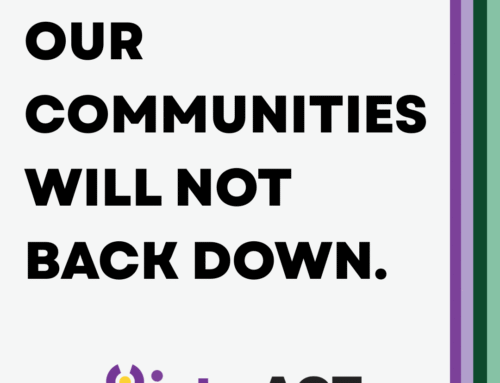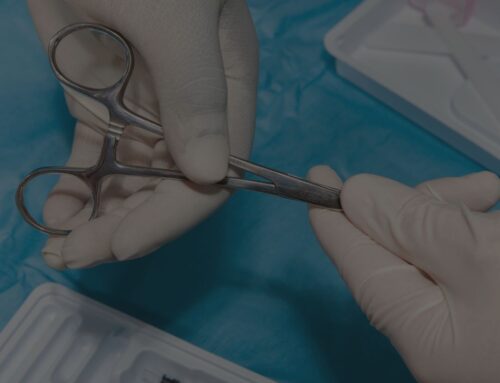One of the most common questions we get at interACT is: how do we handle intersex data collection on a form or survey? Ultimately, there’s no single correct answer. Formatting these questions depends on why you are asking them. We’re here to help guide the process to make sure that your questions are respectful while collecting accurate information.
By the interACT Staff

Note that these guidelines are constantly evolving as we and our allies learn more about best practices from our communities.
General Best Practices For Intersex Data Collection
interACT’s framework for intersex question design is informed by the work of the Williams Institute, with our own changes based on our decades of intersex-specific policy work. Whether you are collecting health information or just demographics, here are some best practices.
Remember that intersex people are born with differences in physical anatomy.
These differences can show up in a person’s genitals, internal sex anatomy, chromosomes, and/or hormones.
While the intersex community has some things in common with LGBTQ communities, being intersex is not the same thing as being transgender or nonbinary, and it’s not a sexual orientation. A person can have intersex bodily differences and be transgender or nonbinary, but an intersex person isn’t automatically one of these things. Even though intersex is about physical anatomy, remember that anatomy is not the same thing as gender. Lots of intersex people do describe their gender as male or female.
Use a definition of “intersex” in the question.
We recommend this approach because it eases two major data problems:
- false negatives when people born with variations in their sex traits do not identify with the term “intersex” (or may have never heard the term), and
- false positives when some people might be drawn to the label of “intersex” but were not born with physical variations.
For example:
Some people are labeled male or female at birth, but are born with physical differences in sex anatomy, reproductive organs, chromosomes, and/or hormone function that do not fit typical expectations. These differences are known as variations in sex characteristics, differences in sex development, intersex traits, or sometimes by specific medical terms (like Congenital Adrenal Hyperplasia or Androgen Insensitivity Syndrome). Were you born with any of these physical differences?
- Yes
- No
- I don’t know
Were you born with a variation in your physical sex characteristics? (This is sometimes called being intersex or having a Difference in Sex Development (DSD).)
- No
- Yes, my chromosomes, genitals, reproductive organs, or hormone functions were observed to be different from the typical male/female binary at birth and/or I have been diagnosed with an intersex variation or Difference of Sex Development
- I don’t know
Language may need to be even further simplified for youth surveys. For example:
Some people are born with bodies that are a little different from what we think of as standard “male” or “female” bodies. For example, some people have genitals that don’t look exactly like most other penises or vaginas, or they might have reproductive organs that aren’t what we’d expect based on how their body looks. This is called being intersex. Are you intersex?
- Yes, I am intersex
- No, I am not intersex
- I do not know if I am intersex
- I do not know what this question is asking
If you know you may have respondents who are ESL speakers, or speak only another language, you’ll need to plan accordingly for language accessibility.
Of course, coming to a definition of intersex is always a tricky task. How ‘significant’ must a difference be to be counted as intersex, and who decides that?
Prioritizing medical language in your definition means more rigid and specific categories for when a bodily difference is ‘significant’ enough to be counted as intersex. It can also come with drawbacks. Which brings us to…
Figure out if relying on medical diagnosis language matters to your data.
Many intersex people are born with clearly visible physical differences, like genital differences, or hormonal differences that cause unexpected developments at puberty. They may not have formal medical language for their intersex status, nor need it to know that their body is different. Some other intersex people with known differences may have variations that their doctors were never able to conclusively match to an exact diagnosis.
Relying on medical language comes with the benefit of guarding against some false positives. However, this approach can result in false negatives by locking many people out. We know that those locked out will be those with less access to, or reason to trust, our medical systems—for example, people affected by racism, ableism, and economic oppression.
If you’re asking questions in a healthcare setting, medical diagnosis terms are more likely to matter, because different intersex variations come with very different combinations of body parts, hormones, and considerations for patient care.
Intersex Status, Sex, and Gender Questions
Intersex people, like anyone, can have any gender and sexual orientation—all three of these are different pieces of information.
While some people with intersex variations do hold their intersex status as an important part of their gender, intersex should not be added as a gender identity option. We find that including the term as an answer to a question on gender identity risks drawing false positives—people without intersex traits who may think the word is synonymous with gender-related terms like nonbinary or transgender.
Collecting each item separately will give the clearest picture:
- Sex assigned at birth (e.g. “male” or “female” based on a doctor’s assumptions about anatomy)
- Intersex status (e.g. “were you born with physical differences?” per above)
- Gender identity (e.g. male, female, nonbinary, Two Spirit, other)
- Pronouns (e.g. she/her, he/him, they/them, other)
- Sexual orientation, if relevant
Limitations of “Sex Assigned at Birth”
People born with visible intersex variations are almost always still assigned “male” or “female” on their birth certificates and raised socially as a boy or a girl. Therefore, “sex assigned at birth” is generally not a useful question on its own for determining someone’s intersex status.
“Sex assigned at birth” can also miss important information. If your project is about health information, “sex assigned at birth” does not capture what parts a person currently does/n’t have, due to intersex status, surgery, or any other reasons. See the section below on organ inventories.
Writing Intersex Questions for Research, Hospitals, and Health Intakes
We recommend all of the above, plus the following.
In healthcare settings, specifics matter.
You may need to know what organs a person does/n’t have, how they process hormones, or how their body may otherwise react differently. One quick way to outline this information is by asking for a specific medical term for an intersex variation, if the person has it. Not all will. For example, this phrasing adapted from the dsd-LIFE survey:
If you answered “yes” to the previous question [re: having intersex traits], please select any of the variations or medical terms that apply to you:
- 5-Alpha reductase deficiency (5-ARD)
- 17-Beta-hydroxysteroid dehydrogenase deficiency
- Aphallia
- Bladder exstrophy
- Clitoromegaly (large clitoris)
- Classic Congenital Adrenal Hyperplasia (Classic CAH)
- Complete Androgen Insensitivity Syndrome (CAIS)
- Cryptorchidism (undescended testicle/s)
- de la Chapelle (XX Male) syndrome
- Epispadias
- Fraser Syndrome
- Gonadal dysgenesis (partial or complete)
- Hypospadias
- Jacobs/XYY Syndrome
- Kallmann Syndrome
- Klinefelter Syndrome
- Late Onset Congenital Adrenal Hyperplasia (late onset CAH)
- Leydig Cell Hypoplasia
- Micropenis
- Mosaicism involving ‘sex’ chromosomes
- MRKH (Mullerian agenesis; vaginal agenesis; congenital absence of vagina)
- Mullerian (Duct) aplasia
- Ovo-testes (formerly ‘true hermaphroditism’)
- Partial Androgen Insensitivity Syndrome (PAIS)
- Persistent Mullerian Duct Syndrome
- Polycystic Ovary Syndrome (PCOS)/Hyperandrogenism
- Progestin Induced Virilisation
- Swyer Syndrome
- Turner Syndrome (TS, one X chromosome)
- Triple-X Syndrome (XXX)
- XXY/47
- XY/XO Mosaics
- XY-Turner Syndrome
- Another variation _______________
- I don’t know / I don’t have specific medical terms
Dealing With Binary Coding in Healthcare Systems
You may also need to collect information in a way that will comply with binary sex categories in insurance and billing systems. We recommend a clear explanation for patients to ease any feelings of invalidation that might come with having to give this answer, while also helping them avoid administrative or financial headaches. For example:
“Regardless of how you answered questions about your gender and anatomy, insurance companies usually need to designate a patient’s sex as either ‘male’ or ‘female’ in their billing systems. There may be delays or issues with coverage if claims we submit on your behalf do not match the sex designation on your insurance records.
For insurance purposes only, please select the sex category we should use when submitting claims to your insurance company:
- Male
- Female
If you are intersex or transgender and have questions about sex designations and insurance coverage, please let your care providers know.
Improve Care with an Organ Inventory
When measuring something that may be a sex-based difference between “men” and “women,” how are you defining those categories? If the answer has anything to do with body parts, hormonal environments, or physical differences, you’ve got a lot more questions to answer.
If someone can only mark “male” or “female” on a medical chart, that carries many assumptions about their body. These assumptions lead to worse care, or important details missed. Intersex people might have vastly different bodies compared to the assumptions behind these two labels. The same goes for transgender people, as well as any person who may have had certain surgeries, e.g. a hysterectomy.
If you are providing healthcare or collecting any data that might depend on body parts represented by “sex” questions, we recommend an organ inventory. An organ inventory makes sure that patients are not asked about parts they don’t have, nor losing any important care if relevant parts are assumed to be absent.
See this paper for an example of an organ inventory. Keep in mind that intersex people may have some organ options that are not on standard examples, e.g. streak gonads, ovotestes, or testes that are inside the body.
In Conclusion
- If you have more specific questions on intersex question design, you can contact our team at info@interactadvocates.org.
- See our policy for participation in research if you are looking to conduct research with intersex populations.
- If our resources have helped your work, please consider supporting interACT with a donation.






